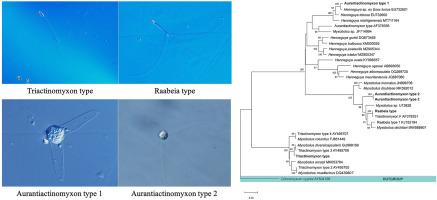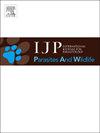四种新型鱼类寄生粘孢子类型的特征以及匈牙利养鱼场中出现的 Branchiodrilus hortensis 和 Ophidonais serpentina
IF 2
3区 医学
Q3 ECOLOGY
International Journal for Parasitology-Parasites and Wildlife
Pub Date : 2024-09-18
DOI:10.1016/j.ijppaw.2024.100994
引用次数: 0
摘要
从匈牙利 Ráckeve 多瑙河渔业协会的 Szigetbecse 和 Makád 养殖场采集的寡毛目动物肠上皮细胞中发现了六种不同的放线孢子类型。从三个无脊椎动物宿主物种的形态学和分子学上描述了四种新类型:三触角虫型、raabeia 型、aurantiactinomyxon 1 型和 aurantiactinomyxon 2 型:Limnodrilus hoffmeisteri、Ophidonais serpentina 和 Tubifex tubifex。18S 核糖体 DNA(rDNA)分析表明,这些新型放线孢子与 GenBank 中的任何肌孢子序列都不匹配。系统进化分析将三触角肌球蛋白型归入寄生于鲤科鱼类的肌球蛋白支系,而raabeia型和aurantiactinomyxon 2型都归入与鲈形目鱼类有关的肌球蛋白支系。Aurantiactinomyxon 1 型被归入一个支系,该支系包含了来自鮨形目鱼类的鳃感染 Henneguya 属。然而,尚未发现肌孢子与本次调查报告的新测序放线孢子有关联。本研究还报告了匈牙利首次出现的两种寡毛虫--Branchiodrilus hortensis 和 Ophidonais serpentina,特别是在 Ráckeve 多瑙河臂渔业协会的养鱼场中。此外,这也是关于蛇尾藻参与粘虫生命周期的首份报告。本文章由计算机程序翻译,如有差异,请以英文原文为准。

Characterization of four novel actinospore types of fish parasitic myxozoans and the occurrence of Branchiodrilus hortensis and Ophidonais serpentina from fish farms of Hungary
Six distinct actinospore types were identified in the intestinal epithelium of oligochaetes collected from the Szigetbecse and Makád fish farms of Ráckeve Danube Arm Fishing Association, in Hungary. Four new types: triactinomyxon type, raabeia type, aurantiactinomyxon type 1, and aurantiactinomyxon type 2, were described morphologically and molecularly from three invertebrate host species: Limnodrilus hoffmeisteri, Ophidonais serpentina, and Tubifex tubifex. The 18S ribosomal DNA (rDNA) analysis revealed that these new types of actinospores did not match any myxospore sequences available in GenBank. Phylogenetic analysis placed the triactinomyxon type within the Myxobolus clade that parasitizes cyprinid fish, while the raabeia type and aurantiactinomyxon type 2 were both placed within the Myxobolus clade associated with Perciformes fish. Aurantiactinomyxon type 1 was clustered in a clade containing gill-infecting Henneguya spp. from Esociformes fish. However, no myxospores have been found yet to link to the newly sequenced actinospores reported in this survey. This study also reports the first occurrence of two oligochaetes species, Branchiodrilus hortensis and Ophidonais serpentina in Hungary, specifically in fish farms of Ráckeve Danube Arm Fishing Association. Moreover, this is the first report on the involvement of Ophidonais serpentina in the life cycle of myxozoans.
求助全文
通过发布文献求助,成功后即可免费获取论文全文。
去求助
来源期刊

International Journal for Parasitology-Parasites and Wildlife
Medicine-Infectious Diseases
CiteScore
3.80
自引率
5.60%
发文量
113
审稿时长
45 days
期刊介绍:
The International Journal for Parasitology: Parasites and Wildlife (IJP-PAW) publishes the results of original research on parasites of all wildlife, invertebrate and vertebrate. This includes free-ranging, wild populations, as well as captive wildlife, semi-domesticated species (e.g. reindeer) and farmed populations of recently domesticated or wild-captured species (e.g. cultured fishes). Articles on all aspects of wildlife parasitology are welcomed including taxonomy, biodiversity and distribution, ecology and epidemiology, population biology and host-parasite relationships. The impact of parasites on the health and conservation of wildlife is seen as an important area covered by the journal especially the potential role of environmental factors, for example climate. Also important to the journal is ''one health'' and the nature of interactions between wildlife, people and domestic animals, including disease emergence and zoonoses.
 求助内容:
求助内容: 应助结果提醒方式:
应助结果提醒方式:


